Abstract
Increased construction of residential canal communities along the southern coastline of the United States has led to a concern about their impact on water quality. Pollution of such dead-end canals is potentially hazardous because of their heavy usage for recreational activities. Coliforms, fecal coliforms, and salmonellae in the surface water and bottom sediments of six selected residential coastal canals were monitored over a period of 17 months. No statistically significant relationship was observed between the organism concentrations and temperature, pH, turbidity, and suspended solids content of water. An inverse relationship between the concentration of indicator organism and salinity of water was found, however, to occur at a 99.9% level of significance. All of the microorganisms studied were found to be present in greater numbers in sediments than in the overlying water, often by a factor of several logs. Heavy rainfall resulted in large increases in the number of organisms in both water and sediment samples. Our results indicate that bottom sediments in the shallow canal systems can act as reservoirs of enteric bacteria, which may be resuspended in response to various environmental factors and recreational activities.
Full text
PDF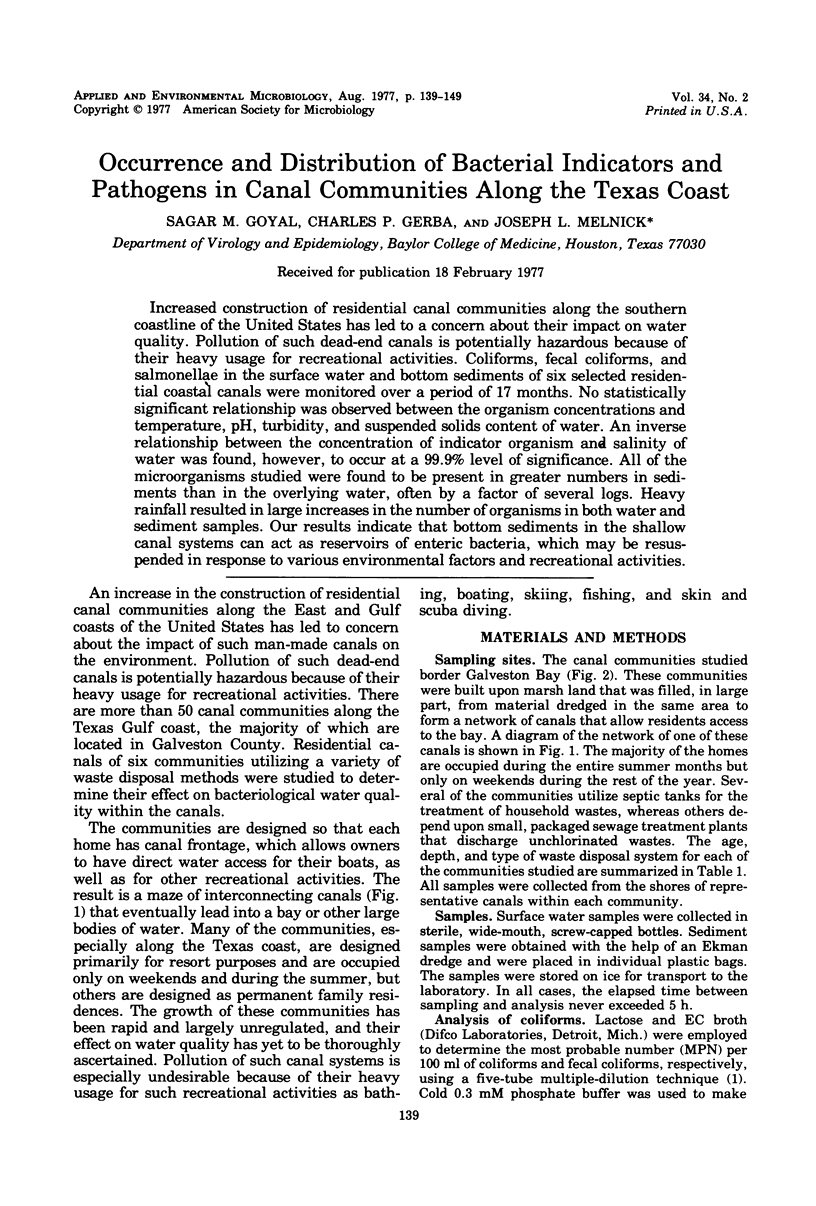
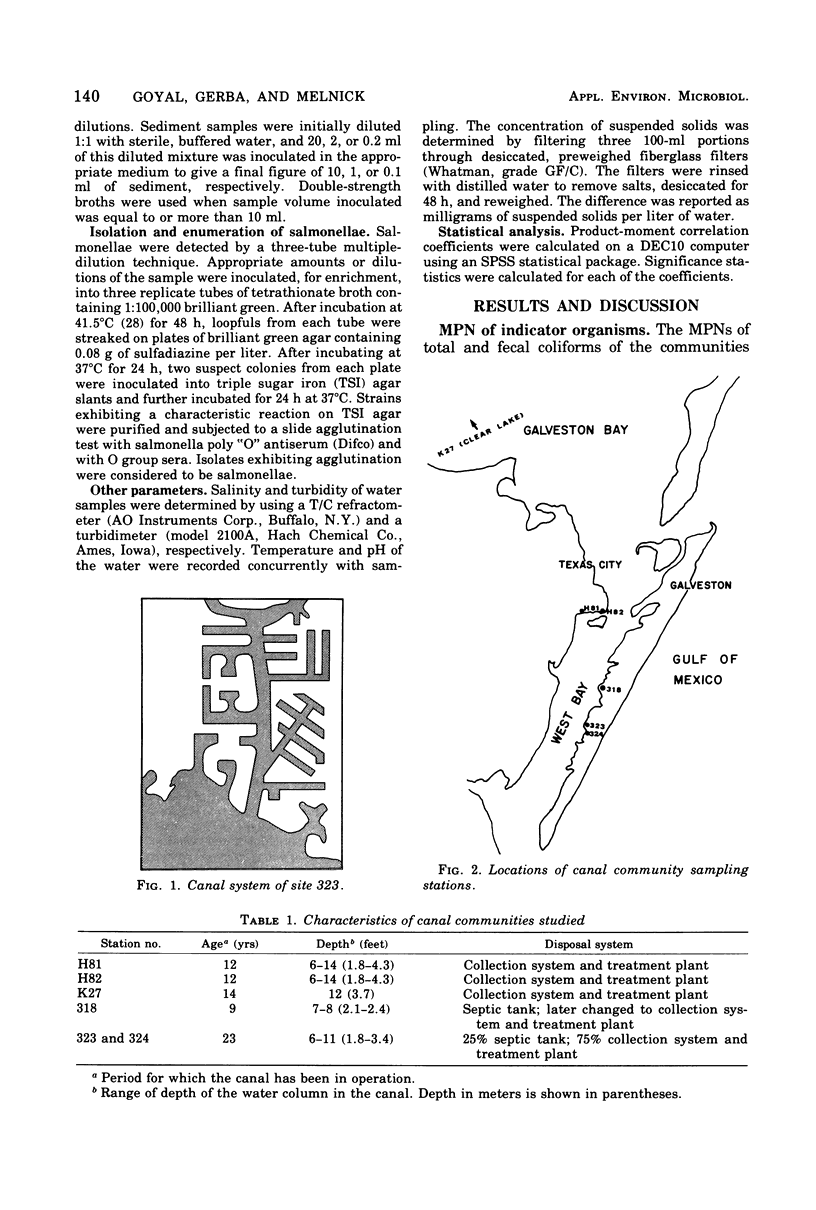
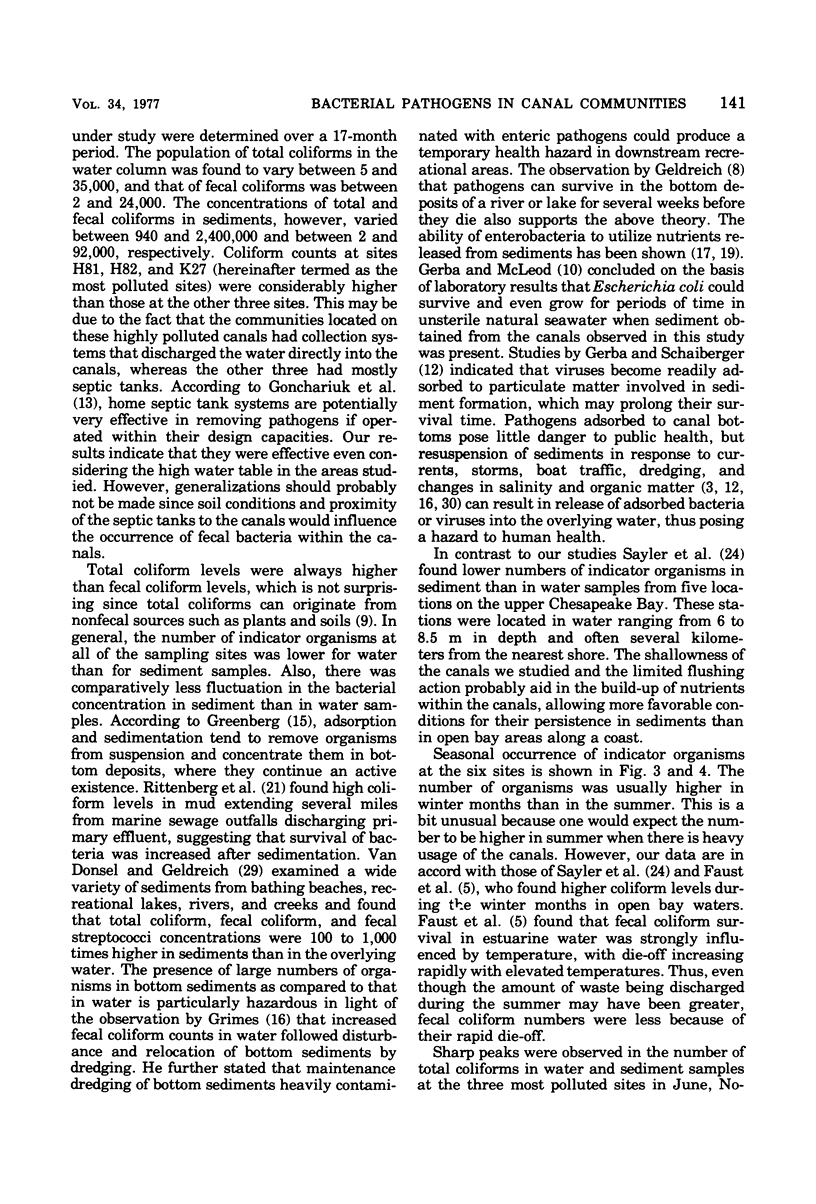


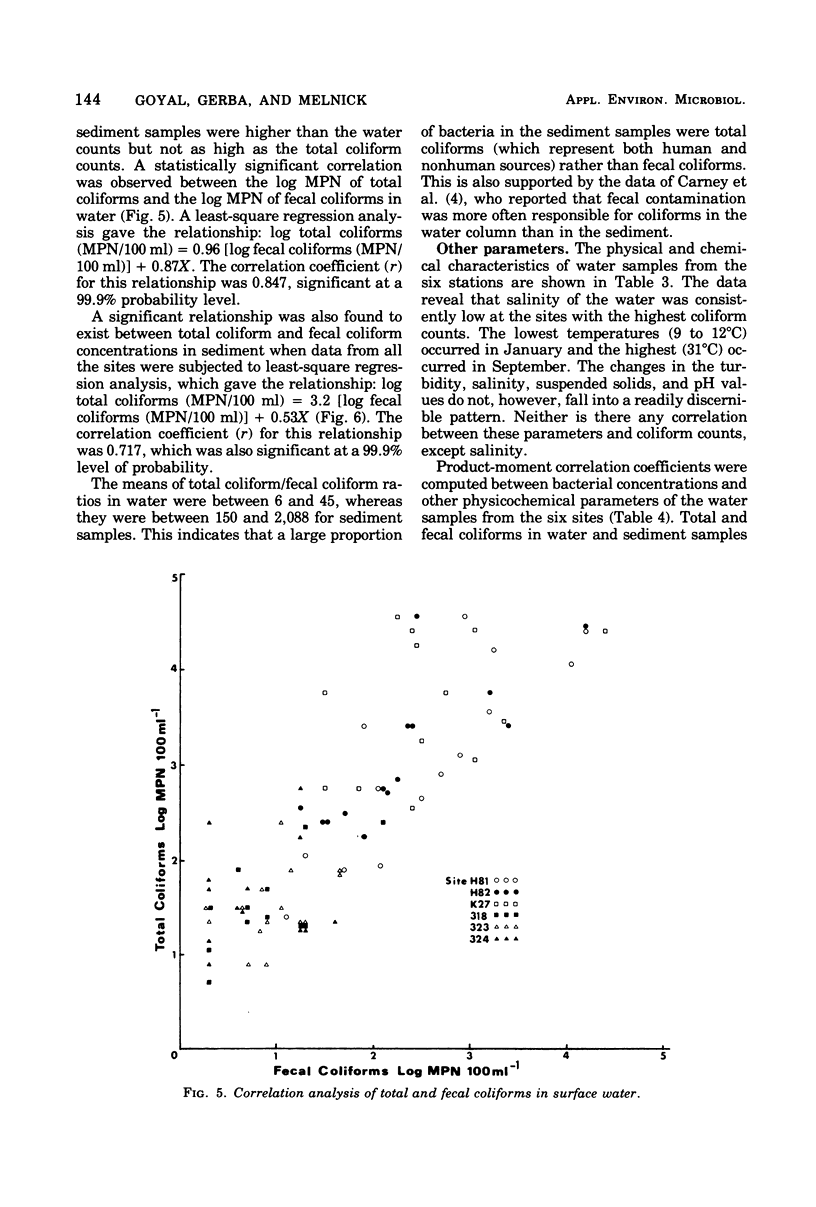



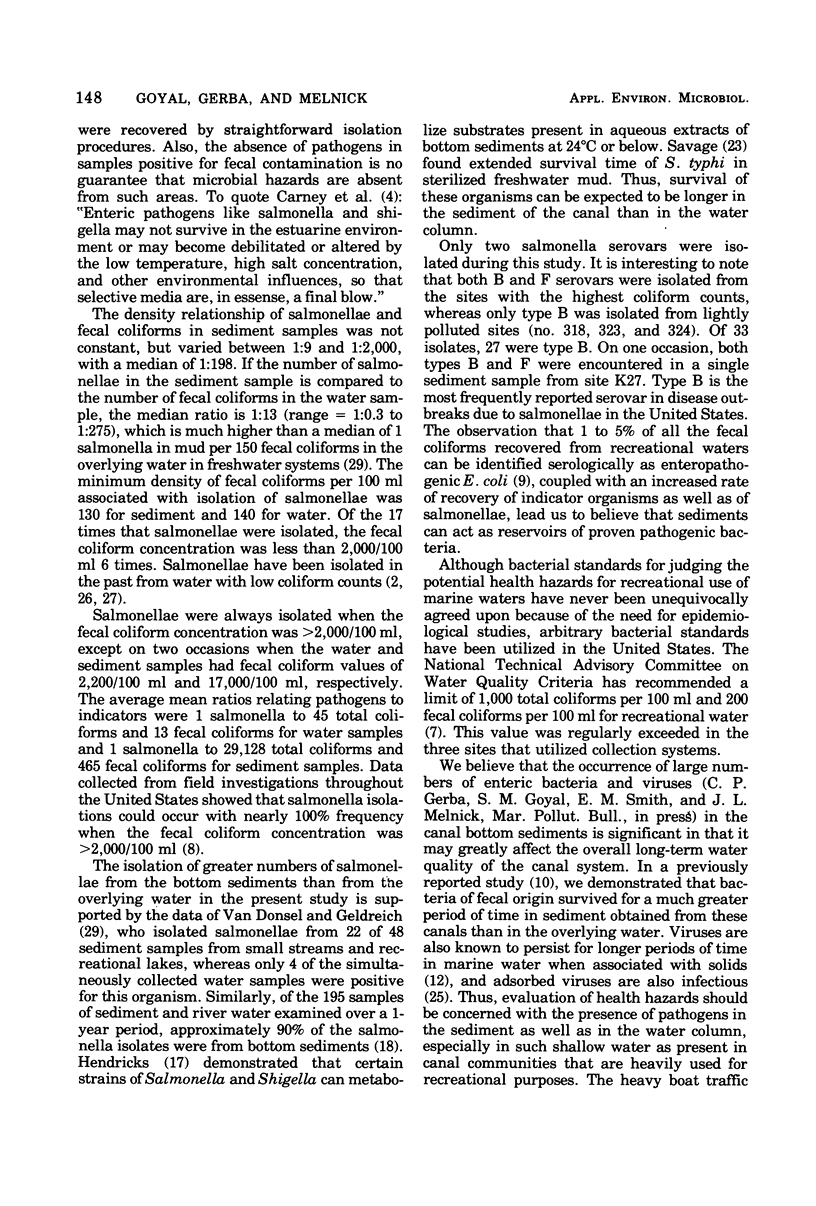

Selected References
These references are in PubMed. This may not be the complete list of references from this article.
- Boring J. R., 3rd, Martin W. T., Elliott L. M. Isolation of Salmonella typhi-murium from municipal water, Riverside, California, 1965. Am J Epidemiol. 1971 Jan;93(1):49–54. doi: 10.1093/oxfordjournals.aje.a121227. [DOI] [PubMed] [Google Scholar]
- Carney J. F., Carty C. E., Colwell R. R. Seasonal occurrence and distribution of microbial indicators and pathogens in the Rhode River of Chesapeake Bay. Appl Microbiol. 1975 Nov;30(5):771–780. doi: 10.1128/am.30.5.771-780.1975. [DOI] [PMC free article] [PubMed] [Google Scholar]
- Faust M. A., Aotaky A. E., Hargadon M. T. Effect of physical parameters on the in situ survival of Escherichia coli MC-6 in an estuarine environment. Appl Microbiol. 1975 Nov;30(5):800–806. doi: 10.1128/am.30.5.800-806.1975. [DOI] [PMC free article] [PubMed] [Google Scholar]
- GREENBERG A. E. Survival of enteric organisms in sea water. Public Health Rep. 1956 Jan;71(1):77–86. [PMC free article] [PubMed] [Google Scholar]
- Gerba C. P., McLeod J. S. Effect of sediments on the survival of Escherichia coli in marine waters. Appl Environ Microbiol. 1976 Jul;32(1):114–120. doi: 10.1128/aem.32.1.114-120.1976. [DOI] [PMC free article] [PubMed] [Google Scholar]
- Gerba C. P., Schaiberger G. E. Effect of particulates on virus survival in seawater. J Water Pollut Control Fed. 1975 Jan;47(1):93–103. [PubMed] [Google Scholar]
- Goncharuk E. I., Savchenko G. V., Leviant M. A. Ochistka stochnykh vod, soderzhashchikh vozbuditeli briushnogo tifa, na eksperimental'nykh sooruzheniiakh podzemnoi fil'tratsii. Gig Sanit. 1966 Jun;31(6):13–16. [PubMed] [Google Scholar]
- Gray E. A. Survival of Escherichia coli in stream water in relation to carbon dioxide and plant photosynthesis. J Appl Bacteriol. 1975 Aug;39(1):47–54. doi: 10.1111/j.1365-2672.1975.tb00544.x. [DOI] [PubMed] [Google Scholar]
- Grimes D. J. Release of sediment-bound fecal coliforms by dredging. Appl Microbiol. 1975 Jan;29(1):109–111. doi: 10.1128/am.29.1.109-111.1975. [DOI] [PMC free article] [PubMed] [Google Scholar]
- Hendricks C. W. Enteric bacterial metabolism of stream sediment eluates. Can J Microbiol. 1971 Apr;17(4):551–556. doi: 10.1139/m71-090. [DOI] [PubMed] [Google Scholar]
- Sayler G. S., Nelson J. D., Jr, Justice A., Colwell R. R. Distribution and significance of fecal indicator organisms in the Upper Chesapeake Bay. Appl Microbiol. 1975 Oct;30(4):625–638. doi: 10.1128/am.30.4.625-638.1975. [DOI] [PMC free article] [PubMed] [Google Scholar]
- Schaub S. A., Sagik B. P. Association of enteroviruses with natural and artificially introduced colloidal solids in water and infectivity of solids-associated virions. Appl Microbiol. 1975 Aug;30(2):212–222. doi: 10.1128/am.30.2.212-222.1975. [DOI] [PMC free article] [PubMed] [Google Scholar]
- Smith R. J., Twedt R. M., Flanigan L. K. Relationships of indicator and pathogenic bacteria in stream waters. J Water Pollut Control Fed. 1973 Aug;45(8):1736–1745. [PubMed] [Google Scholar]
- Spino D. F. Elevated-temperature technique for the isolation of Salmonella from streams. Appl Microbiol. 1966 Jul;14(4):591–596. doi: 10.1128/am.14.4.591-596.1966. [DOI] [PMC free article] [PubMed] [Google Scholar]
- Witzenhausen R. Aus welcher Wassertife soll die Wasserprobe für die bakteriologische Untersuchung entnommen werden. Zentralbl Bakteriol Orig B. 1972 Dec;156(4):373–382. [PubMed] [Google Scholar]


